Stogie Spirits: Jim Beam Distillers Series Bourbon
6 Jan 2009
In 1964 Bourbon was declared America’s Native Spirit, and the most popular bourbon around is Jim Beam. Indeed, Beam’s ubiquitous white label and square bottle is behind every bar in America. But today I examine a rarer Beam: the “Distillers Series,” a limited release in celebration of over two centuries of Beam distilling and the 75th anniversary of the repeal of prohibition.
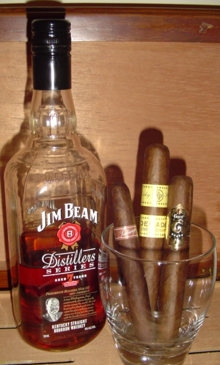 The concept behind Distillers Series is to celebrate seven generations of master distillers: from Jacob Beam, founder of the Jim Beam name who first made Old Jake Beam Sour Mash in 1795, to Frederick Booker Noe III, who oversees production today. The clear special release bottle features a photo and a brief blurb about each of the seven generations of Beam distillers.
The concept behind Distillers Series is to celebrate seven generations of master distillers: from Jacob Beam, founder of the Jim Beam name who first made Old Jake Beam Sour Mash in 1795, to Frederick Booker Noe III, who oversees production today. The clear special release bottle features a photo and a brief blurb about each of the seven generations of Beam distillers.
You’ll have to forgive me, though, if I’m more concerned with what is in the bottle than what is on it. Inside is a new Beam recipe that’s aged seven years and distilled to 90 proof, making it slightly stronger than Beam’s regular seven-year bourbon. That bourbon is a deep golden amber color. On the nose the Distillers Series has plenty of sweet honey, some oak, and a bit of pepper.
Upon sipping this copper-colored Kentucky spirit I find that same honey, classic corn flavor, oak, char, and muted pepper. It is remarkably smooth and easy to drink either straight up—where it’s fiery finish comes through—or on the rocks for a long, warm, smooth finish.
Like any bourbon good enough to be enjoyed on straight up, the Distillers Series pairs well with a variety of cigars. The Coronado by La Flor paired particularly well, as did a CAO Brazilia. I would shy away from particularly mild cigars that would be overpowered.
Overall, the Jim Beam Distillers Series is an impressive bourbon considering its $21 price tag. While it isn’t as complex as many of the small batch premium bourbons available today such as Knob Creek—a personal favorite of mine and another Beam company bourbon—the Distillers Series is a smooth, pleasant sipping bourbon that, due to its price, won’t bring you to tears if your friend wastes some by mixing it with cola.
So if you appreciate the history of the worlds best-known bourbon, or just want a good Kentucky whiskey to pair with cigars at a reasonable price, I suggest picking up some Jim Beam Distillers Series before if disappears from shelves at the end of the month.
photo credit: Stogie Guys

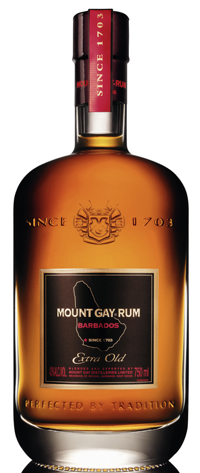 Despite all that, before tasting it for this article I wasn’t all that familiar with the Mount Gay Extra Old, sometimes called Mount Gay Black. Both the Extra Old (XO) and the Eclipse are made in Mount Gay’s Barbados distillery, where rum has been made since at least 1703, making it the longest continually produced brand of rum in the world. While the Eclipse is top notch mixing rum, the Extra Old is more of a sipping rum, best appreciated straight up or on the rocks.
Despite all that, before tasting it for this article I wasn’t all that familiar with the Mount Gay Extra Old, sometimes called Mount Gay Black. Both the Extra Old (XO) and the Eclipse are made in Mount Gay’s Barbados distillery, where rum has been made since at least 1703, making it the longest continually produced brand of rum in the world. While the Eclipse is top notch mixing rum, the Extra Old is more of a sipping rum, best appreciated straight up or on the rocks.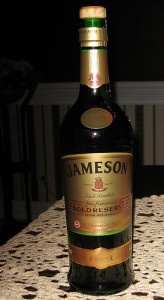 But maybe you’re looking for something a little more exquisite this holiday season. Whether you’re shopping for yourself, a friend, or a loved one, I don’t think you can go wrong with the new Jameson Irish Whiskey Gold Reserve.
But maybe you’re looking for something a little more exquisite this holiday season. Whether you’re shopping for yourself, a friend, or a loved one, I don’t think you can go wrong with the new Jameson Irish Whiskey Gold Reserve.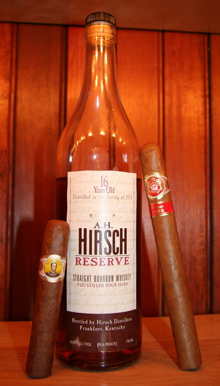 Originally distilled in 1974, A.H. Hirsch is the oldest pot stilled bourbon available in the U.S., at least since the 20-year-old version sold out. Today it is distributed by Preiss Imports, which bought all the remaining reserves of the Michter’s Distillery when the historic Pennsylvania site went bankrupt in 1988.
Originally distilled in 1974, A.H. Hirsch is the oldest pot stilled bourbon available in the U.S., at least since the 20-year-old version sold out. Today it is distributed by Preiss Imports, which bought all the remaining reserves of the Michter’s Distillery when the historic Pennsylvania site went bankrupt in 1988.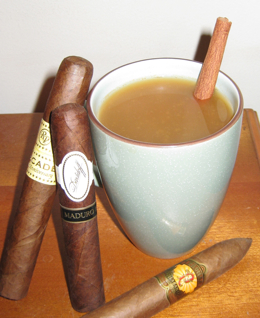 Now some say that enough alcohol itself has warming qualities—and having had my fair share of tequila and whiskey I’m not sure I disagree—but I’m looking for an immediate and obviously warm drink. At times like this I often turn to a reliable warm apple cider and bourbon, also known as a “Stonewall Jackson” (so named because the revered
Now some say that enough alcohol itself has warming qualities—and having had my fair share of tequila and whiskey I’m not sure I disagree—but I’m looking for an immediate and obviously warm drink. At times like this I often turn to a reliable warm apple cider and bourbon, also known as a “Stonewall Jackson” (so named because the revered 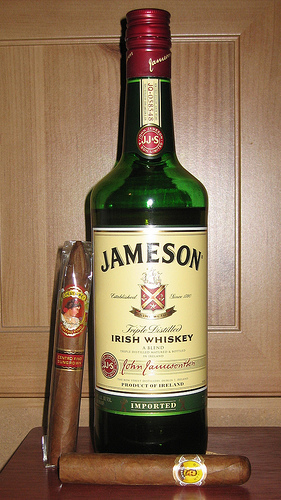 Founded in 1780 by John Jameson in Dublin, this is a very popular whiskey that probably needs no introduction. Jameson has been crowned the fastest growing international whiskey in the world, with sales reaching 2.6 million cases in June.
Founded in 1780 by John Jameson in Dublin, this is a very popular whiskey that probably needs no introduction. Jameson has been crowned the fastest growing international whiskey in the world, with sales reaching 2.6 million cases in June.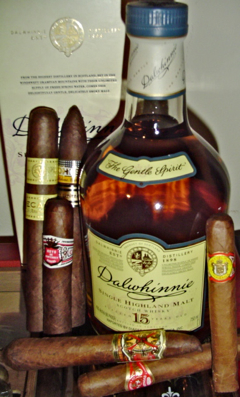 But being owned by a multi-national conglomerate doesn’t mean you can’t produce a fine single malt scotch. Case in point is the Dalwhinnie 15 year, a fine example from the Highland region. According to its
But being owned by a multi-national conglomerate doesn’t mean you can’t produce a fine single malt scotch. Case in point is the Dalwhinnie 15 year, a fine example from the Highland region. According to its  Patrick Ashby
Co-Founder & Editor in Chief
Patrick Ashby
Co-Founder & Editor in Chief Patrick Semmens
Co-Founder & Publisher
Patrick Semmens
Co-Founder & Publisher George Edmonson
Tampa Bureau Chief
George Edmonson
Tampa Bureau Chief